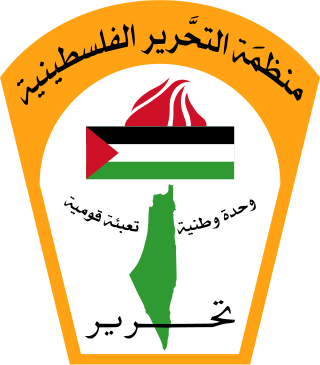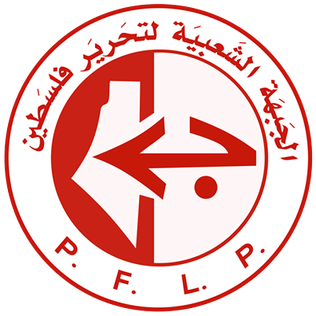
Fatah, formally the Palestinian National Liberation Movement, is a Palestinian nationalist and social democratic political party. It is the largest faction of the confederated multi-party Palestine Liberation Organization (PLO) and the second-largest party in the Palestinian Legislative Council (PLC). Mahmoud Abbas, the President of the Palestinian Authority, is the chairman of Fatah.

The Palestine Liberation Organization is a Palestinian nationalist coalition that is internationally recognized as the official representative of the Palestinian people in both the Palestinian territories and the diaspora. It is currently represented by the Palestinian Authority based in the West Bank city of Al-Bireh.

Yasser Arafat, also popularly known by his kunya Abu Ammar, was a Palestinian political leader. He was chairman of the Palestine Liberation Organization (PLO) from 1969 to 2004, President of the State of Palestine from 1989 to 2004 and President of the Palestinian Authority (PNA) from 1994 to 2004. Ideologically an Arab nationalist and a socialist, Arafat was a founding member of the Fatah political party, which he led from 1959 until 2004.

The Popular Front for the Liberation of Palestine – General Command or PFLP-GC is a Palestinian nationalist militant organisation based in Syria. It is a member the Palestine Liberation Organization (PLO).

The history of the Israeli–Palestinian conflict traces back to the late 19th century when Zionists sought to establish a homeland for the Jewish people in Ottoman-controlled Palestine, a region roughly corresponding to the Land of Israel in Jewish tradition. The Balfour Declaration of 1917, issued by the British government, endorsed the idea of a Jewish homeland in Palestine, which led to an influx of Jewish immigrants to the region. Following World War II and the Holocaust, international pressure mounted for the establishment of a Jewish state in Palestine, leading to the creation of Israel in 1948.

Khalil Ibrahim al-Wazir was a Palestinian leader and co-founder of the nationalist party Fatah. As a top aide of Palestine Liberation Organization (PLO) Chairman Yasser Arafat, al-Wazir had considerable influence in Fatah's military activities, eventually becoming the commander of Fatah's armed wing al-Assifa.

Black September, also known as the Jordanian Civil War, was an armed conflict between Jordan, led by King Hussein, and the Palestine Liberation Organization (PLO), led by chairman Yasser Arafat. The main phase of the fighting took place between 16 and 27 September 1970, though certain aspects of the conflict continued until 17 July 1971.
The government of Palestine is the government of the Palestinian Authority or State of Palestine. The Executive Committee of the Palestine Liberation Organization (EC) is the highest executive body of the Palestine Liberation Organization and acts as the government. Since June 2007, there have been two separate administrations in Palestine, one in the West Bank and the other in the Gaza Strip. The government on the West Bank was generally recognised as the Palestinian Authority Government. On the other hand, the government in the Gaza Strip claimed to be the legitimate government of the Palestinian Authority. Until June 2014, when the Palestinian Unity Government was formed, the government in the West Bank was the Fatah-dominated Palestinian government of 2013. In the Gaza Strip, the government was the Hamas government of 2012. Following two Fatah–Hamas Agreements in 2014, on 25 September 2014 Hamas agreed to let the PA Government resume control over the Gaza Strip and its border crossings with Egypt and Israel, but that agreement had broken down by June 2015, after President Abbas said the PA government was unable to operate in the Gaza Strip.

Palestinian political violence refers to acts of violence or terrorism committed by Palestinians with the intent to accomplish political goals, and often carried out in the context of the Israeli–Palestinian conflict. Common objectives of political violence by Palestinian groups include self-determination in and sovereignty over all of Palestine, or the recognition of a Palestinian state inside the 1967 borders. This includes the objective of ending the Israeli occupation. More limited goals include the release of Palestinian prisoners held by Israel and recognition of the Palestinian right of return.
The Cairo Agreement, or Cairo Accord, was an agreement reached on 2 November 1969 during talks between Yasser Arafat and the Lebanese army commander, General Emile Bustani. Egyptian President Gamal Abdel Nasser helped to broker the deal.

Hamastan is a pejorative neologism, blending Hamas, a Palestinian political party with a military wing, and -stan, a suffix of Persian origin meaning "home of/place of". The term Hamastan generally relates to the Hamas administration of Gaza.
The Prisoners' Document, officially the National Conciliation Document of the Prisoners was written in May 2006 by Palestinian prisoners, who were being held in an Israeli jail. The five prisoners who took part in writing the Document were respectively affiliated with Fatah, Hamas, Islamic Jihad, the Popular Front for the Liberation of Palestine (PFLP), and the Democratic Front for the Liberation of Palestine (DFLP).

Palestinian fedayeen are militants or guerrillas of a nationalist orientation from among the Palestinian people. Most Palestinians consider the fedayeen to be freedom fighters, while most Israelis consider them to be terrorists.

The Palestinian insurgency in South Lebanon was a multi-sided armed conflict initiated by the Palestinian Liberation Organization (PLO) against Israel in 1968 and against Lebanese Christian militias in the mid-1970s. PLO's goals evolved during the insurgency; by 1977, its goal was to pressure Israel into allowing a Palestinian state in the West Bank and Gaza Strip. In 1982, Israel invaded Lebanon and expelled the PLO, thereby ending the insurgency.

The Popular Front for the Liberation of Palestine is a secular Palestinian Marxist–Leninist and revolutionary socialist organization founded in 1967 by George Habash. It has consistently been the second-largest of the groups forming the Palestine Liberation Organization (PLO), the largest being Fatah.

The Democratic Front for the Liberation of Palestine is a secular Palestinian Marxist–Leninist and Maoist organization. It is also frequently referred to as the Democratic Front, or al-Jabha al-Dīmūqrāṭiyya. It is a member organization of the Palestine Liberation Organization, the Alliance of Palestinian Forces and the Democratic Alliance List.
The 2014 Fatah–Hamas Agreements were two successive reconciliation agreements between Fatah and Hamas, concluded in 2014. The Gaza Agreement was signed in Gaza City on 23 April 2014 by Ismail Haniyeh, the prime minister of the Hamas administration in Gaza, and a senior Palestine Liberation Organisation delegation dispatched by Palestinian President Mahmoud Abbas. Its main purpose was reconciliation between the parties and the formation of a Palestinian Unity Government within five weeks, to be followed by general elections within six months. The Unity Government was formed on 2 June 2014.

A series of attempts to resolve the hostility between Fatah and Hamas have been made since their 2006–2007 conflict and the subsequent violent conflict over the Gaza Strip.
The Palestinian Cairo Declaration was a declaration signed on 19 March 2005 by twelve Palestinian factions, including Fatah, Hamas, Islamic Jihad, Popular Front for the Liberation of Palestine (PFLP) and Democratic Front for the Liberation of Palestine (DFLP). The Cairo Declaration affirmed the status of the Palestine Liberation Organization (PLO) as the sole legitimate representative of the Palestinian people through the participation in it of all forces and factions according to democratic principles. The Declaration implied a reform of the PLO by the inclusion in the PLO of Hamas and Islamic Jihad.












